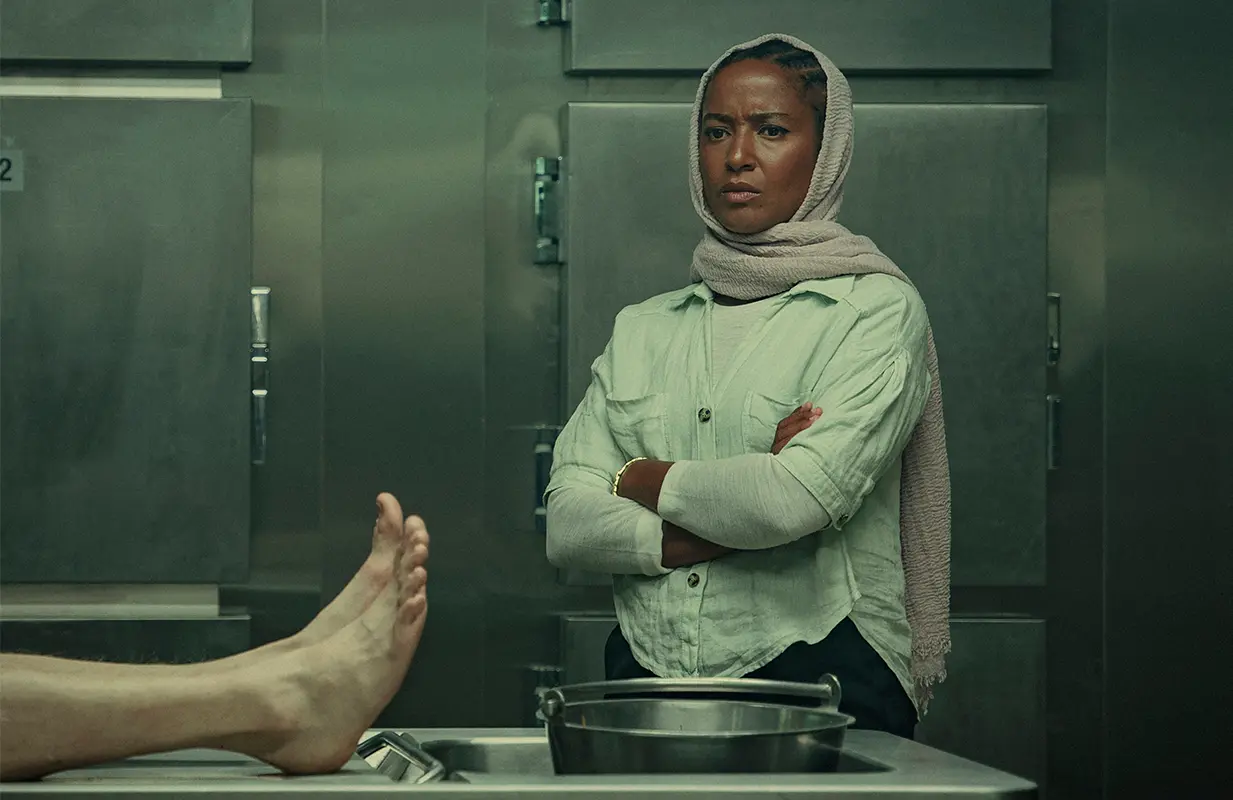Netflix Has a Hit on Its Hands With Time-Traveling Murder Mystery Bodies
-
 Amaka Okafor in Bodies (Photo: Matt Towers/Netflix)
Amaka Okafor in Bodies (Photo: Matt Towers/Netflix)Netflix's Bodies has everything: a naked man who died under mysterious circumstances, a shadowy organization pulling the strings behind the scenes, queer romance, and references to the myriad societal and cultural problems (including homophobia, antisemitism, and racism) plaguing London. Based on the graphic novel by Si Spencer, the limited series covers a lot of ground as four detectives investigate the sudden appearance of a body on Longharvest Lane in East London. But Bodies is hardly a regular police procedural. While each detective lives in a different time period — 1890, 1941, 2023, and 2053 — they all stumble upon the same body, prompting questions about their connection to one another and the larger conspiracy at play.
As is to be expected, Bodies' throw-it-all-at-the-wall approach creates a bit of a mess. Though the specifics of the plot are kept deliberately murky, it's not always clear what's going on, even as the link between the detectives and their stories is slowly revealed. The drama only becomes more convoluted with the introduction of Elias Mannix, who plays various roles and appears in different forms in each timeline, including as a troubled child (Gabriel Howell) implicated in Detective Shahara Hasan's (Amaka Okafor) 2023 investigation, and as an enigmatic leader (Stephen Graham) who rules over the futuristic society of 2053.
However, the structure of the show allows creator Paul Tomalin to play with tone and genre, with each portion taking inspiration from its respective era. In 1890, Inspector Alfred Hillinghead (Kyle Soller), a Sherlock Holmes-type, uses his cunning and keen observation skills to identify his prime suspect, the figure who appears in the window of a crime scene photo taken by journalist Henry Ashe (George Parker). (Hillinghead's spidey senses are further activated when his superiors tell him to destroy the photo and prematurely close the case.) The 1941 storyline leans into noir as Sergeant Charles Whitehead (Jacob Fortune-Lloyd) — born "Weissman," as his Nazi-sympathizer colleague (Jonny Coyne) frequently reminds him — acts on orders from an anonymous woman who ends every phone call with the same phrase: "Know you are loved." Hasan's present-day storyline embraces realism as she struggles to reconcile her identity as a Black, Muslim woman with her career in law enforcement — although it quickly becomes clear that her faith and empathy make her far better suited to the job than the white men around her.
And while science fiction elements appear throughout the show, the 2053 timeline commits to them wholeheartedly: With his face projected onto street corners and his slogan ("Know You Are Loved," or "KYAL") emblazoned on high-rise buildings like billboards in Times Square, Mannix quite literally watches over London and the citizens living under his rule. For her part, Detective Iris Maplewood (Shira Haas) has a robotic spine that enables her to walk after she was badly injured 30 years ago during "the blast," a disaster that devastated the city's population. It's precisely because of this life-altering technology that Maplewood is so committed to protecting the society Mannix has built and his way of life; when Mannix charges her with stopping a terrorist group known as Chapel Perilous that threatens to "erase [their] progress," she agrees without questioning his motives.
As Bodies' quadrants intersect and the detectives begin to collaborate from across the decades, the line between science and historical fiction becomes more blurred. Each story remains grounded in specifics of the era — Hillinghead and Ashe begin a clandestine romantic relationship and Whiteman becomes responsible for an orphaned Jewish girl (Chloe Raphael), among other developments — but these narrative beats take a back seat to the mystery surrounding Mannix and the KYAL movement. Emphasizing the conspiracy focuses the limited series, which becomes more compelling as the eight-episode season progresses toward its final twist.
Although Netflix has been quiet on the limited series front of late, Bodies, with its intriguing blend of sci-fi, period drama, and procedural tropes, has the potential to be a breakout hit for the streamer. The British series may not be the best time-traveling drama or murder mystery out there, but it stands as an exciting amalgamation of the two.
Bodies is now streaming on Netflix. Join the discussion about the show in our forums.
Claire Spellberg Lustig is the Senior Editor at Primetimer and a scholar of The View. Follow her on Twitter at @c_spellberg.
TOPICS: Bodies, Netflix, Amaka Okafor, Jacob Fortune-Lloyd, Kyle Soller, Paul Tomalin, Shira Haas, Stephen Graham